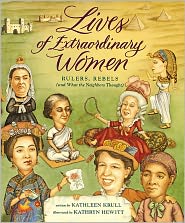March 29 - Today's post contributed by Alyson Beecher
Woman Who Faced Amazing Challenges & Succeeded
by Alyson Beecher
My simple search produced some familiar names and some names that were new to me. Helen Keller was obviously on the list but so was Harriet Tubman, and Frida Kahlo. Each of these women have numerous biographies written about them in both picture book and long-form. The famous photographer, Dorothea Lange is well known for her photography but lesser known for the limp she grew up with as a result of polio when she was a child. Wilma Mankiller, Principal Chief of the Cherokee Nation, has a chapter in a picture book celebrating famous woman and her work with the Cherokee Nation, but did you know she also served in this position while having a rare form of muscular dystrophy? Really, just a chapter in a picture book?
However, I learned about some other woman who had made notable contributions to their communities and countries and yet, little were written about them. Jhamak Ghimire who has severe cerebral palsy and considered the “Helen Keller of Nepal” has nothing written about her in the United States, except for her own work of poetry. Judy Neumann, and Harilyn Rousso have had significant careers and lives advocating for individuals with disabilities and yet despite their life's work would not be easily recognized by most teachers and children.
After serving on the Schneider Family Book Award Jury (a children’s and young adult book award committee of the American Library Association) for the past few years, I have read a lot of books featuring individuals with special needs. However, in the category for young children, with the exception of books about Helen Keller, there were no books portraying the lives of any of these other amazing woman and the work that they have done while also living with additional challenges. Do we have a book gap? I would certainly say yes.
Though this is not a comprehensive list by any means, I would like to highlight the lives of just a few of the incredible woman who embody the spirit and essence that surrounds Women’s History Month and who are also powerful role models for our young readers who may be empowered to dream beyond their special needs because of these amazing women.
 |
| Moses: When Harriet Tubman Led Her People to Freedom by Carole Boston Weatherford; Illustrated by Kadir Nelson |
 |
| Frida by Jonah Winter; Illustrated by Ana Juan |
 |
| Viva Frida by Yuyi Morales |
One of the things that have always struck me is how Frida Kahlo was able to utilize her pain and life experiences to produce so many amazing pieces of art. As a child, she contracted polio and was left with a limp, then at 18 she was in a serious bus accident, which left her in chronic pain. Kahlo lived a colorful live with her marriage to artist Diego Rivera and her political activism.
 |
| Dorothea Lange by Mike Venezia |
 |
| Amelia to Zora: Twenty-six Women Who Changed the World by Cynthia Chin-Lee; Illustrated by Megan Halsey, Sean Addy |
 |
| Photo of Wilma Mankiller taken at the 2001 Cherokee National Holiday. Photo by Phil Konstantin |
 |
| Harilyn Rousso |
 |
| Judith Heumann, Photo from U.S. State Department |
 |
| "Jhamakawarded" by Madan Puraskar org . Licensed under CC BY-SA 3.0 via Wikimedia Commons http://commons.wikimedia.org/wiki/File:Jhamakawarded.jpg#/media/File:Jhamakawarded.jpg |
 |
| Helen’s Big World: The Life of Helen Keller by Doreen Rappaport; Illustrated by Matt Tavares |
What strikes me about each of these women is how hard they must have worked. Each one of these women shows us what is possible despite our personal limitations. When I think of the headaches that Harriet Tubman experienced or the chronic pain of Frida Kahlo, I am in awe. Pain is hard and yet, neither of these women allowed it to stop them from accomplishing what they were meant to do.
Mankiller, Heumann, and Rousso dedicated their lives to advocating for others. When I look at the accomplishments of these women, I almost feel like an underachiever. They have not allowed what might be seen by others as limitations to limit them.
Lange, Kahlo, and Ghimire have used their experiences to enhance their artistic expression. Ghimire is particularly inspiring in that her own country as well as her body would have left her without a voice and yet through her writing she has found that voice.
Next time, I find myself thinking I am unable to do something, I need to remind myself how much each of these women have contributed to their communities and even the world by what they were able to accomplish while facing incredible challenges.
 Alyson Beecher is an educator, book geek and literacy advocate with over 20 years of experience in education. Currently, she is the K-8 Literacy Specialist for the Pasadena Unified School District in Pasadena, CA. Alyson has served as the Chair of the ALA 2015 Schneider Family Book Award Jury and was an Elementary/Middle Grade Nonfiction second round judge for the CYBILS. She can be found on twitter @alybee930 or through her blog www.kidlitfrenzy.com
Alyson Beecher is an educator, book geek and literacy advocate with over 20 years of experience in education. Currently, she is the K-8 Literacy Specialist for the Pasadena Unified School District in Pasadena, CA. Alyson has served as the Chair of the ALA 2015 Schneider Family Book Award Jury and was an Elementary/Middle Grade Nonfiction second round judge for the CYBILS. She can be found on twitter @alybee930 or through her blog www.kidlitfrenzy.com























